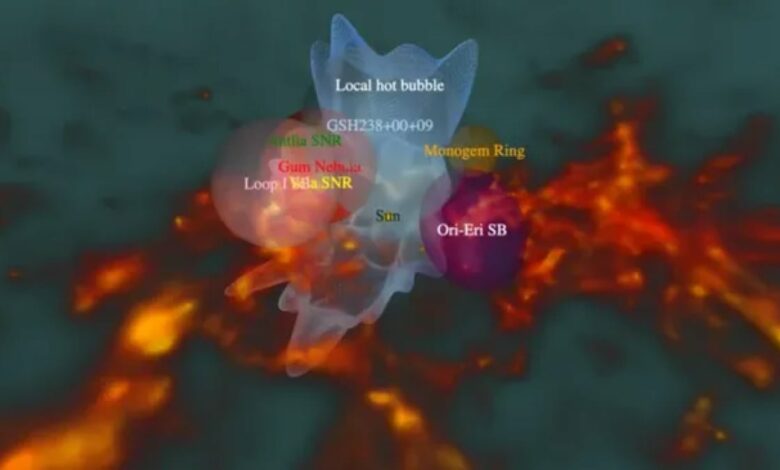New 3D map of local hot bubble reveals interstellar tunnel to Superbubble

Astronomers have created a detailed three-dimensional map of the Local Hot Bubble (LHB), a vast region of low density surrounding our solar system. This bubble, filled with hot, X-ray-emitting gas, has been a subject of research since the 1970s, and recent data from the eROSITA All-Sky Survey have provided new insights into its structure and history. The eROSITA telescope, operating as part of the Spectrum-Roentgen-Gamma (SRG) mission, has allowed astronomers to view the bubble with unprecedented clarity by observing X-ray activity from outside Earth’s geocorona.
The new map reveals intriguing temperature variations within the LHB, attributed to stellar winds and supernova explosions. These phenomena cause certain parts of the bubble to expand, creating a more dynamic picture of its evolution. A special discovery is the identification of an ‘escape tunnel’ aimed at the constellation Centaurus. This tunnel could be a connection to another superbubble in the Milky Way, formed by active young stars.
The history of the local hot bubble
The presence of the LHB has been recognized for almost fifty years and its origin is believed to be related to supernova activity. Early studies of the bubble were hampered by interference from X-rays in the Earth’s atmosphere. However, the eROSITA telescope, launched in 2019, has now provided astronomers with the cleanest X-ray data from the bubble. Michael Yeung, a researcher at the Max Planck Institute, noted that the eRASS1 data, which was collected during a period of low solar wind activity, provides the most accurate view of the X-ray sky to date.
Mapping the Milky Way’s hemisphere into about 2,000 regions has revealed a temperature difference between the galactic north and south, with the northern hemisphere being cooler. This discovery indicates an internal temperature difference within the LHB.
A new interstellar tunnel and its implications
Along with temperature variations, the eROSITA data has revealed a previously unknown interstellar tunnel pointing toward the constellation Centaurus. This tunnel appears to connect the LHB to a hot gas corridor in the Milky Way, indicating a larger network of such tunnels throughout interstellar space.
The team also noted the presence of dense molecular clouds at the edges of the LHB, possibly a remnant of the bubble’s formation. Gabriele Ponti, an MPE scientist, emphasized that the solar system is at the center of this bubble, although the Sun only entered the LHB a few million years ago – a brief moment in the Sun’s 4.6 billion year history.




